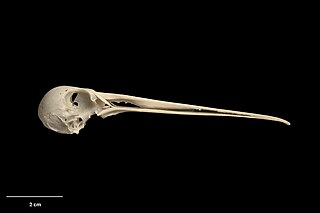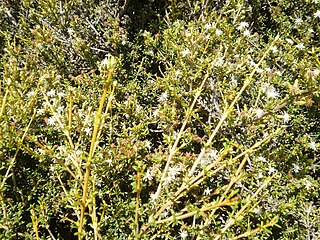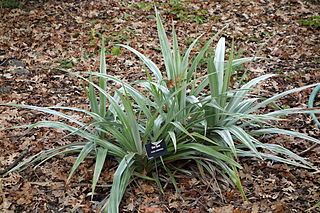
Olearia, most commonly known as daisy-bush, is a genus of flowering plants belonging to the family Asteraceae, the largest of the flowering plant families in the world. Olearia are found in Australia, New Guinea and New Zealand. The genus includes herbaceous plants, shrubs and small trees. The latter are unusual among the Asteraceae and are called tree daisies in New Zealand. All bear the familiar daisy-like composite flowerheads in white, pink, mauve or purple.
The flora of the Chatham Islands consists of around 388 terrestrial plant species, of which 47 are endemic. The Chatham Islands make up the Chatham floristic province of the Neozeylandic Region of the Antarctic Kingdom.

Olearia lyallii is a New Zealand plant from the genus Olearia. It is commonly known as the subantarctic tree daisy. The species is endemic to the Snares Islands and southern New Zealand, and has also established itself as an introduced species on the Auckland Islands, whence the type specimen was described. O. lyallii forms trees up to 10 m tall with trunks 50 cm in diameter.

Olearia angulata is a species of flowering plant in the family Asteraceae. It is found only in New Zealand.

Olearia fragrantissima is a species of flowering plant in the family Asteraceae. It is found only in New Zealand. It is threatened by habitat loss.

Olearia hectorii is a species of flowering plant in the daisy family Asteraceae. Its common names include deciduous tree daisy and Hector's tree daisy. It is endemic to New Zealand, where it is nationally endangered.

Olearia polita is a species of flowering plant in the family Asteraceae. It is found only in New Zealand.

Olearia traversiorum, the Chatham Island akeake, or Chatham Island tree daisy, is a species of flowering plant in the family Asteraceae. It is endemic to the Chatham Islands of New Zealand. It is also known by the synonym O. traversii.

Xylotoles costatus, the Pitt Island longhorn beetle, is a species of beetle in the family Cerambycidae. It is endemic to the Chatham Islands. Once thought to be extinct, it is now known to survive on South East Island/Rangatira; being therefore an example of a so-called "Lazarus taxon".

Forbes's snipe is an extinct species of New Zealand snipe formerly endemic to the Chatham Islands. It was the larger of two species found there, the smaller being the surviving Chatham snipe. It was never seen alive by scientists and is known only from fossil material collected on the islands. Why it became extinct while its smaller relative survived is a mystery, as is the exact timing of its extinction, although it may have survived, unnoticed, until the 15th century.

Anas chathamica, the Chatham duck or Chatham Island duck is an extinct species of duck which once lived in New Zealand's Chatham Islands in the south-west Pacific Ocean. It likely became extinct in about the 16th century because of hunting by humans.

Olearia rani, or heketara as it is known in Māori is a common small forest tree of New Zealand. It grows in lowland forest throughout the North Island and in the northern half of the South Island. Olearia rani var. rani has a more northern range than Olearia rani var. colorata which is found in forests from the Coromandel south to the Buller River. Its leaves have white undersides and prominent veins. During the spring the tree produces clusters of small white flowers.
Beyeria Conservation Park is a protected area in the Australian state of South Australia located on Kangaroo Island in the gazetted locality of Haines, about 16 kilometres south of Kingscote on the northern edge of the MacGillivray Plain.

Olearia odorata, the scented tree daisy, is a small divaricating shrub endemic to New Zealand, from the plant family Asteraceae. It has small light green leaves with a large amount of interlacing twigs and grows to around 2–4m in height. In spring O. odorata produces many small white flowers.

Olearia solandri, commonly known as coastal daisy-bush or coastal tree daisy, is a coastal shrub of New Zealand in the Asteraceae family.

Astelia chathamica, the Chatham Islands kakaha, Maori flax, or silver spear, is a species of flowering plant in the recently named family Asteliaceae. It is an evergreen silver-green perennial from the Chatham Islands of New Zealand, growing to about 1.2 m (4 ft) tall. Forming a large clump of sword-shaped leaves, it produces small green flowers and red berries. It grows best in partial shade and in fertile and well-drained soil with moderate water. The plant is hardy down to −3 °C (27 °F), but the foliage may be damaged by frost, so in colder areas the plant may require some winter protection.

Sophora chathamica, the coastal kōwhai, sometimes known as Chatham Island kōwhai, is one of 8 species of native sophora or kōwhai in New Zealand and grows naturally in the north-west of the North Island in New Zealand, as far south as the Tongaporutu River in north Taranaki, and as far north as Te Paki. It can also be found growing near Wellington and the Chatham Islands, although these later plantings are thought to be a result of Māori plantings in the late 18th century and early 19th century. Prior to 2001, it was included as variant of Sophora microphylla, therefore references to either Sophora microphylla var. chathamica or Sophora microphylla subsp. microphylla var. chathamica are considered references to coastal kowhai.
Verran Tanks Conservation Park is a protected area in the Australian state of South Australia, located on the Eyre Peninsula in the gazetted locality of Verran about 105 kilometres (65 mi) north of Port Lincoln and about 55 kilometres (34 mi) south-east of Lock.
















